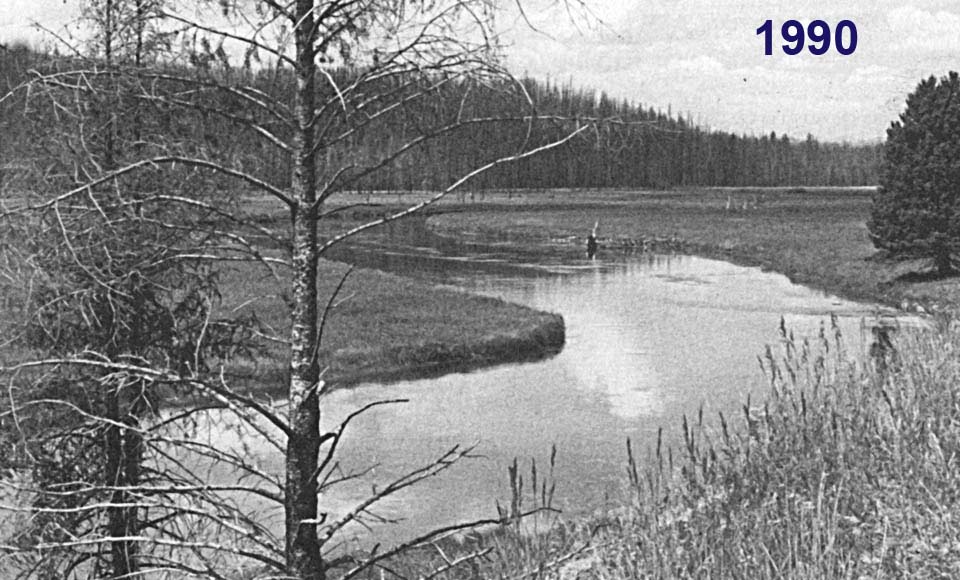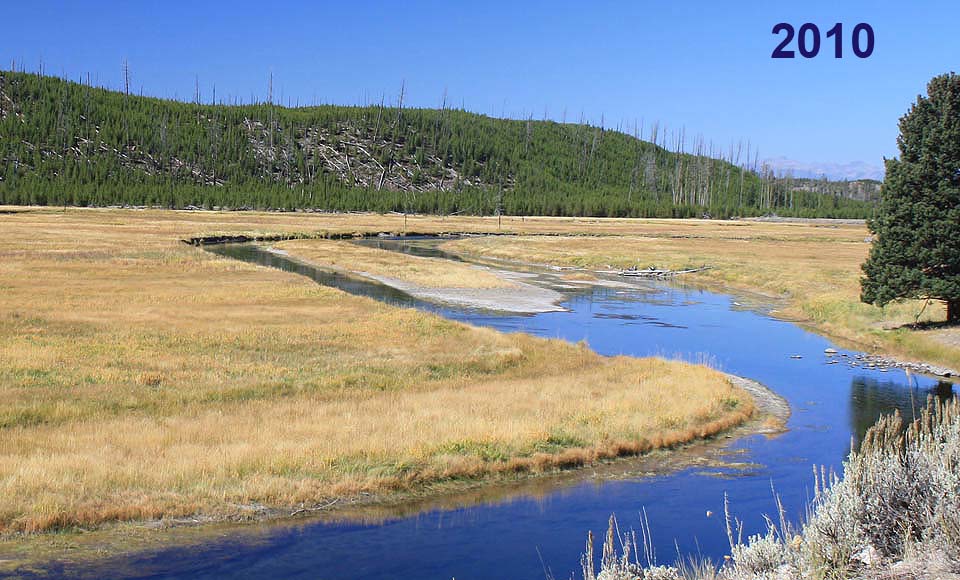This riparian ecosystem is now greatly changed from past conditions. Similar degradation of stream-side vegetation has occurred along the Lamar River and in Yancey’s Hole in the northern part of the park. Please visit this page for how Yellowstone’s Madison River riparian zones could be restored.
Killed with Kindness: Natural Regulation and National Parks Ecosystems
We humans, like all living beings, are essentially utilitarian—our fundamental role is to use resources in the most efficient way possible to propagate our species. However, our species is so efficient that under some circumstances we have the luxury to conserve, or forego resource use for some higher purpose. Establishment of national parks is exemplary of this thinking. Parks allow other forms of life to persist, and give us wonderful locations to enjoy “wild” environments and consider our human heritage as hunters and gathers.
But how exactly how do we manage these landscapes? The large national parks in the Rocky Mountains such as Yellowstone and Banff attempt to protect all parts and processes of an ecosystem. This is a relatively new idea, and over the last century their conservation is a process of trial and error. Initially, the thinking was to eliminate many obvious sources of animal and plant killing by humans or other species. In the late 1800s and early 1900s, federal governments of United States, Canada and other like-minded countries removed native peoples from parks, stopped poaching by white settlers, and maintained predator control programs to stop killing by four legged species. Wildlife was divided into good species (birds and watchable game) and bad species (predators and other “varmints”). For plants, fire suppression programs kept the landscape green. By the late 1930s, park managers realized that their actions were actually “killing with kindness” some areas of protected ecosystems. With reduced predation, the numbers of native ungulates such as elk burgeoned, and their heavy use of winter ranges use began to reduce the cover and height of their favoured food plants. Next, for a period of about 4 decades, managers of some parks paradoxically culled both predators such as wolves, and elk, their primary prey. The inconsistent logic of this approach became increasingly obvious. Also, as the decades passed, forests aging due to fire suppression began to die from insect and disease infestations, and researchers began to understand the important ecological role of fire as a rejuvenating process.1
In the 1960s, the new thinking was that wherever possible the role of predators such as First Nations, wolves and grizzly bears should be restored, ungulate culling should be stopped, and wildland fires lit by people or lightning should be encouraged to burn aging pine forests. These fires might restore plant species such as willow and aspen on the elk winter ranges.2 Again however, idealistic park managers would not recognize the long-term role of human hunting, gathering and burning. In Yellowstone, scientists formulated a new paradigm called “natural regulation” and in the environmentalist spirit of the 1960s, it gained broad public support. A fundamental tenet of natural regulation was again to limit human’s long-term influences. The only “good fires” were ignited by lightning. Unless limited by four-legged predators, the accepted norm for herbivore populations would be when starvation occurs– and this might be at high numbers when plant consumption has strong negative effects on susceptible species such as aspen, willow, or poplar. In the short term, this definition often allows managers to continue to “be kind” to ungulate populations. Human hunting and burning is restricted, and the numbers of plant-eaters such as bison and elk increase beyond long-term conditions. 3
By the mid-1990s most of the large Rocky National parks such as Jasper, Banff, Glacier and Yellowstone had to some degree restored predators and fire. But the photographic series of the marshlands along the Madison River provide an illustrative chronicle of how ecology sometimes doesn’t work the way we wish it would. In 1912, dense thickets of willow and cottonwood lined the meandering river. This habitat would have been ideal for beaver, several bird species that use tall deciduous plants, moose, and during deep snow winters, browse for elk or bison. The pile of sticks on the far right of the photograph may be the remains of an old beaver lodge. The image from Charles Cushman’s 1938 kodachrome color slide shows that elk browsing is starting to stunt willow growth along the river banks. Living cottonwoods in fall color are still visible in the background. The spruce tree on the far right has taken root on the site of the possible old beaver lodge, due to its height above the water table. The 1973 photograph shows continued thinning of the riparian zone. National park biologist Mary Meagher observed that willows and cottonwood were dying; she thought perhaps due to effects of an increase in water levels caused by a 1959 earthquake. This seems unlikely because these species are highly tolerant of high water tables, and their declining trend was already ongoing by 1938, and precedes the earthquake. In 1988, the site was dry enough to be swept over by wildfire, and the burning combined with heavy elk and bison browsing appears have eliminated most remaining willow and poplars by the time of the 1990 image 4 and the continuation of this situation is even more evident in 2010.
Scientists have studied ecological changes in the upper Madison watershed since 1993, focussing on the effects of wolf restoration to this landscape. Unfortunately, by this time shrubby deciduous species had almost totally disappeared, so these studies could not describe shrub or tree browsing effects. Wolves colonized the Madison valley in 1998, and estimated winter elk numbers declined from 663 in 1997-98 to 183 in 2006-07. Most interesting was how the remaining elk may avoid wolves by concentrating near humans. The elk group along the busy road that leads through the Seven Mile area, thus maintaining high herbivory impacts even as the overall elk population declined. 5
Bison are now causing some of the most significant ongoing impacts to Yellowstone’s riparian ecosystems. The national park’s natural regulation policy allows the bison population to increase with minimal human influence until the winter season when snow covers the grass, and this forces the large beasts to move out of the park. Near the boundary, migrating animals may be culled by state and federal officials. Unlike their effects on elk numbers, wolves have not substantially limited bison population growth. Historically, human hunting likely limited bison to very low numbers in Yellowstone’s mountain valleys. Especially in winter, people could easily track and kill bison in narrow valleys with deep snow 6. Today, under Yellowstone’s natural regulation policy, hundreds of bison aggregate near on valley bottoms by roadways. They are habituated to humans, and intensely graze locations such as the Seven Mile area, once ecologically-diverse grasslands and shrublands, but now simply weed-infested “grazing lawns”. 7
In the past, terrain such as the upper Madison Canyon would have been avoided by bison, especially when human hunters were present. Likely the closest herds of bison occurred to the east at Red Rocks and Henry’s Lake (click for this bison story), and these were likely the “tips of the fingers” of bison herds that had dispersed from the Great Plains.8 Widely travelled fur trader David Thompson described bison behavior in the mountains after passing through Howse Pass in 1808:
Near the head of the eastern defile we had the good fortune to kill two bison cows; these animals often frequent the gorges of the mountains for the fresh grass, water, and the free(dom) from flies; but are careful not to be shut in by impassable rocks; and on being hunted uniformly make for the open country; yet when found in a narrow place I have seen the Bisons take to the rocky hills and go up to places where they could barely stand, the bison is a headlong animal. 9
Determining what levels of historic (hunting, gathering and burning) and current human influences that should be maintained will remain a critical issue for land managers charged with sustaining and restoring ecosystems. Historical wildlife observations, such as those made David Thompson in the Canadian Rockies, or Osborne Russell on the Yellowstone plateau 10 can provide a long-term perspective to these deliberations.
Map and Footnotes
- Wagner, F. H., R. Foresta, R. B. Gill, D. R. McCullough, M. R. Pelton, W. F. Porter, and H. Salwasser, eds. Wildlife Policies in the U.S. National Parks. Washington, DC: Island Press, 1995; Burns, R. J., and M. Schintz. Guardians of the Wild: A History of the Warden Service of Canada’s National Parks. Calgary: University of Calgary Press, 2000. ↩
- Leopold, A. S., S. A. Cain, C. Cottam, I. N. Gabrielson, and T. L. Kimball. “Report of the Advisory Board on Wildlife Management (The Leopold Report).” Insert 4-63. National Park Magazine. April, 1963. ↩
- Wagner, F.H. Yellowstone’s Destabilized Ecosystem: Elk Effects, Science, and Policy Conflict. Oxford: Oxford University Press. 2006; Plumb, G.E., P.J. White, M.B. Coughenour, R. L. Wallen. Carrying Capacity, Migration, and Dispersal in Yellowstone Bison. Biological Conservation 142 (2009) 2377–2387; Mosley, J.C., J. Fidel, H.E. Hunter, P.O.Husby, C.E. Kay, J. G. Mundinger, AND R.M. Yonk. 2018. “An Ecological Assessment of the Northern Yellowstone Range: Introduction to the Special Issue”. Rangelands 40 (2018):173-176. https://www.sciencedirect.com/journal/rangelands/vol/40/issue/6 ↩
- Meagher, M. and D. B. Houston. Yellowstone and the Biology of Time: Photographs Across a Century. Norman: University of Oklahoma Press. pp. 68-69 ↩
- Garrott, R., P.J. White, and F. Watson. The Ecology of Large Mammals in Central Yellowstone. Amsterdam: Elsvier, 2008 provides excellent data on elk distributions pre, during and post wolf recolonization in the Madison valley. ↩
- Kay, C. E. “Aboriginal Overkill: The Role of Native Americans in Structuring Western Ecosystems.” Human Nature 5 (1994): 359–98 ↩
- Garrott, Ecology of Large Mammals; Mosley, J.C., J. Fidel, H.E. Hunter, P.O.Husby, C.E. Kay, J. G. Mundinger, AND R.M. Yonk. 2018. “An Ecological Assessment of the Northern Yellowstone Range: Introduction to the Special Issue”. Rangelands 40 (2018):173-176. https://www.sciencedirect.com/journal/rangelands/vol/40/issue/6 ↩
- Long-time Yellowstone bison biologist Mary Meagher used “tips of the fingers” analogy to describe historic bison movements in to Yellowstone National Park. (Meagher interview with Cormack Gates, July 15, 2004 p. 66 in Gates, C. and L. Broberg. Yellowstone Bison: The Science and Management of a Migratory Wildlife Population. Missoula: University of Montana Press. 2011.) Meagher’s is an apt description for the complex process by which small herds of bison periodically used mountain valleys several hundred kilometers distant from the massive herds to the east. For more detailed description of bison movements on the west side of the Yellowstone plateau see “Henry’s Lake” repeat photographs ↩
- p.396 in Belyea, B., ed. Columbia Journals: David Thompson. Montreal and Kingston: McGill-Queen’s University Press, 1994. ↩
- Russell, Osborne. Journal of a Trapper. Edited by Aubrey L. Haines. Lincoln: University of Nebraska Press, 1965 ↩




